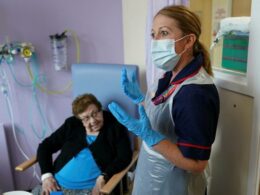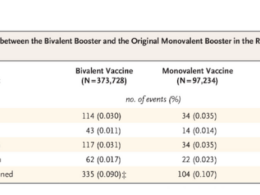A difficult balancing act
EIU — The Economist Intelligence Unit & Microsoft
2021
Employee engagement was a top technology priority for this industry both before and during the pandemic, but they reported not being well-prepared to enable staff to model how the pandemic might impact assets and workforces. The industry also saw increasing digital transformation investment.
Key research findings:
- Healthcare respondents say employee engagement is the top priority in its use of technology in both the pre-covid years and since the pandemic
- Respondents say they were not well-prepared to enable staff to model how the pandemic might play out across assets and workforces
- More than most sectors, Healthcare respondents their organisation’s investment in digital transformation has increased during the pandemic
The global healthcare industry has been tested to its limits by the pressures of tackling the covid-19 pandemic, while simultaneously continuing to deliver on its wider social function of providing people with preventive, curative, rehabilitative and palliative responses to a wide range of health conditions and situations.
Digital transformation in the sector has been invaluable in helping healthcare organisations balance the demands on their time and resources.
In a global survey of 800 executives across eight industries conducted by The Economist Intelligence Unit and sponsored by Microsoft, respondents from the healthcare industry report at above survey-average rates that their organisation’s investment in digital transformation has increased during the pandemic.
- Technology advances have helped to cut costs and boost staff productivity in clinics and hospitals and to keep non-urgent patients under remote monitoring at home, while improving overall care and outcomes.
- Life sciences companies, meanwhile, have used digital technologies to monitor and track the pandemic’s spread and to formulate pharmaceutical responses to it, including the development of vaccines.
- Other advances include electronic health records systems, connected health equipment, wearable devices for patient monitoring, virtual healthcare or telehealth, and online pharmacies.
This may help fund future investments in digital technology; the industry’s reported levels of preparedness to respond to the pandemic suggest several potential areas for improvement.
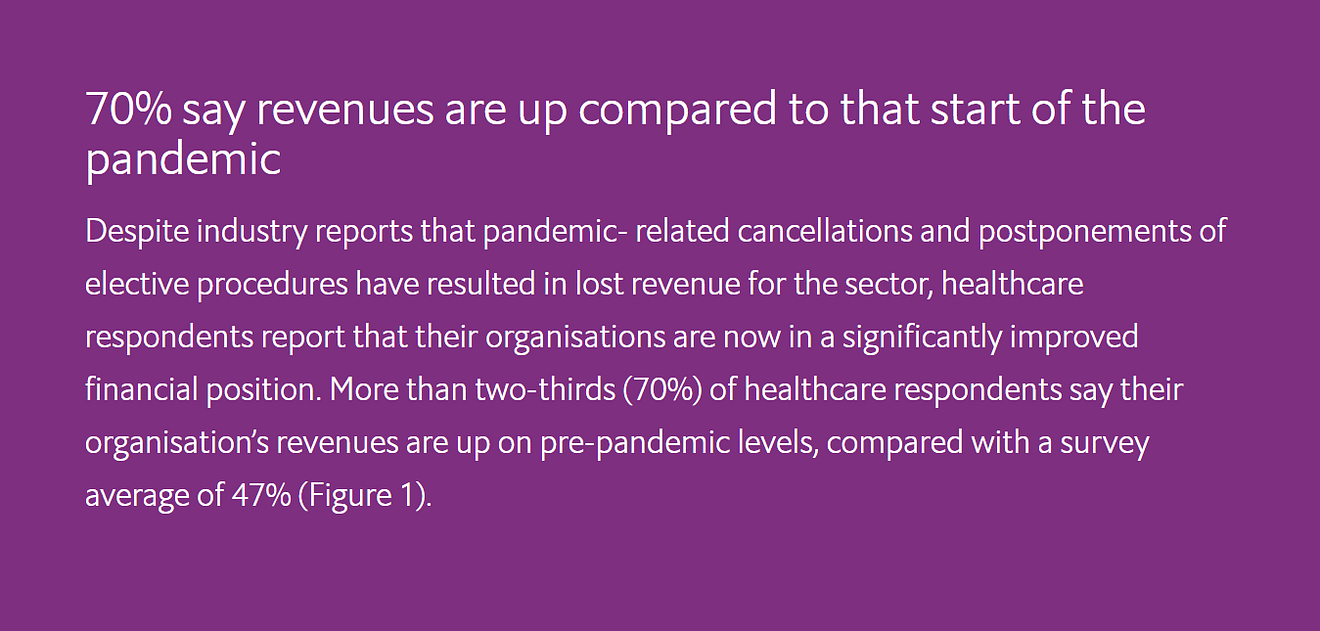
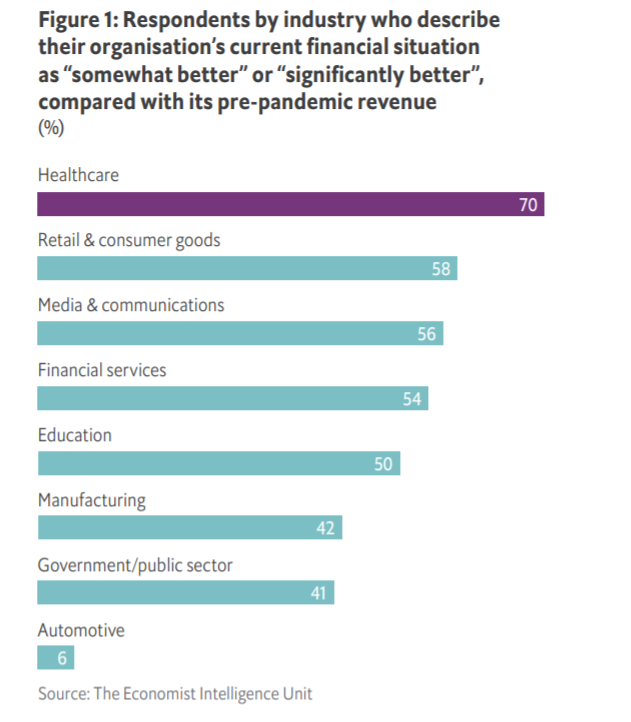
- When asked how prepared their technology infrastructures were to support pandemic- related resilience measures, healthcare respondents report above-average levels in just one area: real-time decision-making.
- The sector reported only average levels of preparedness in monitoring employee safety and was less prepared than other sectors in areas such as making supply-chain/procurement adjustments (as demonstrated via shortages of personal protective equipment), remote work and collaboration, and modelling how the pandemic might play out across assets and workforces.
That last finding, on modelling, is an unexpected one, given that the healthcare industry is expected to be able to handle a whole range of public-health crises, from infectious disease outbreaks to natural disasters involving mass casualties.
Opportunities thus abound for the sector to improve its performance on various preparedness factors, given its place at the epicentre of pandemic response.
Overstretched human resources opens door for more automation
Healthcare workers’ struggles on the frontline of the pandemic have brought their needs sharply into focus, but the sector is unique among all industries surveyed in terms of rating employee engagement as its top priority for technology investment, both in the pre-covid years and the current covid era.
Today, healthcare comes second only to manufacturing — another industry in which many workers simply cannot work from home — in its prioritisation of employee-engagement technology.
- Healthcare respondents view cloud computing as the most important technology for meeting these objectives, followed by apps and devices for remote work and collaboration.
- The Internet of Things comes in third place, signalling an interest in smart medical equipment and wearable health trackers and monitors.
- At the same time, respondents from the sector believe at above-average levels that the pace of technological change may present a barrier to digital transformation in three years’ time.
- They are also far more likely than respondents from other sectors to view increased cyber- security threats as a likely consequence of remote work and collaboration (45% versus a survey average of 34%; Figure 2). This may be a result of recent ransomware attacks on hospitals around the world, combined with ongoing and justified concerns for the security of sensitive patient health records.2
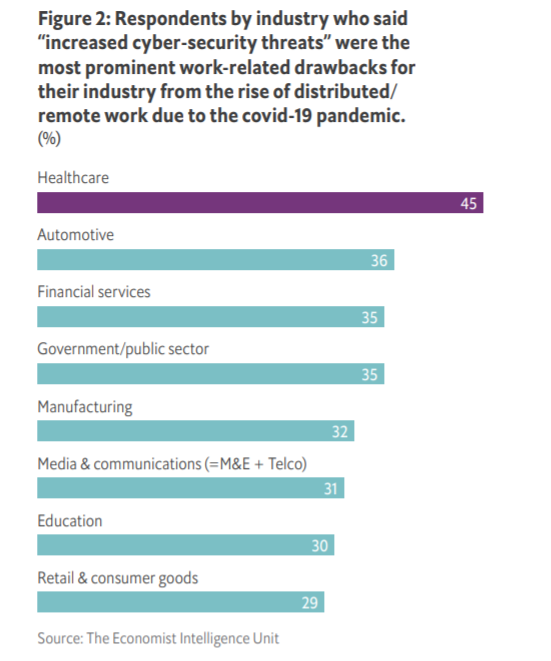
Better treatments for all
The digital transformation of healthcare offers the potential to achieve time and cost efficiencies that could make it possible to offer improved services to wider audiences.

Unsurprisingly, it is the group most likely to place public health and welfare at the top of the list of positive societal impacts of digital transformation in their industry (60% versus a survey average of 31%), followed by public safety.
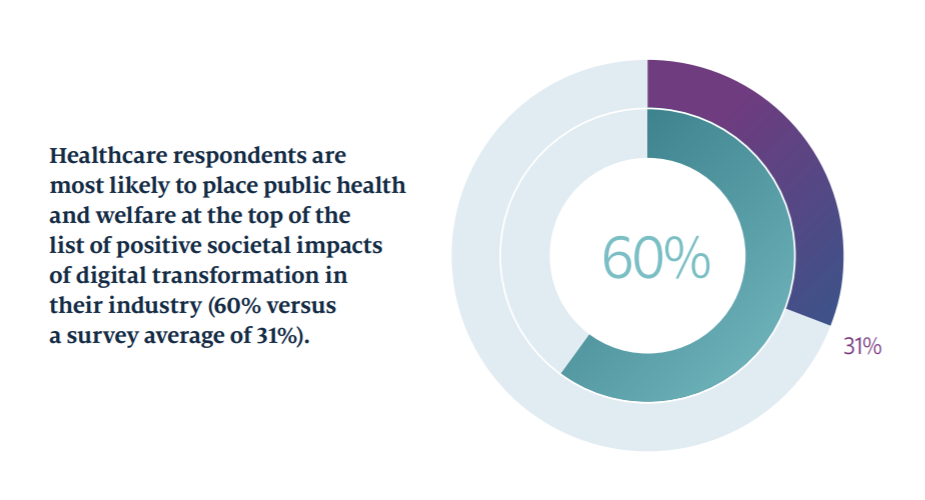
- At the same time, they are also the most likely to agree that public health and welfare will benefit from the wider use of digital technology in society at large (37% versus 30%).
- In particular, they see a big role for digital technology in disaster relief (cited by 24% of healthcare respondents as a societal benefit, compared with a survey average of 17%).
Originally published at the EIU:






